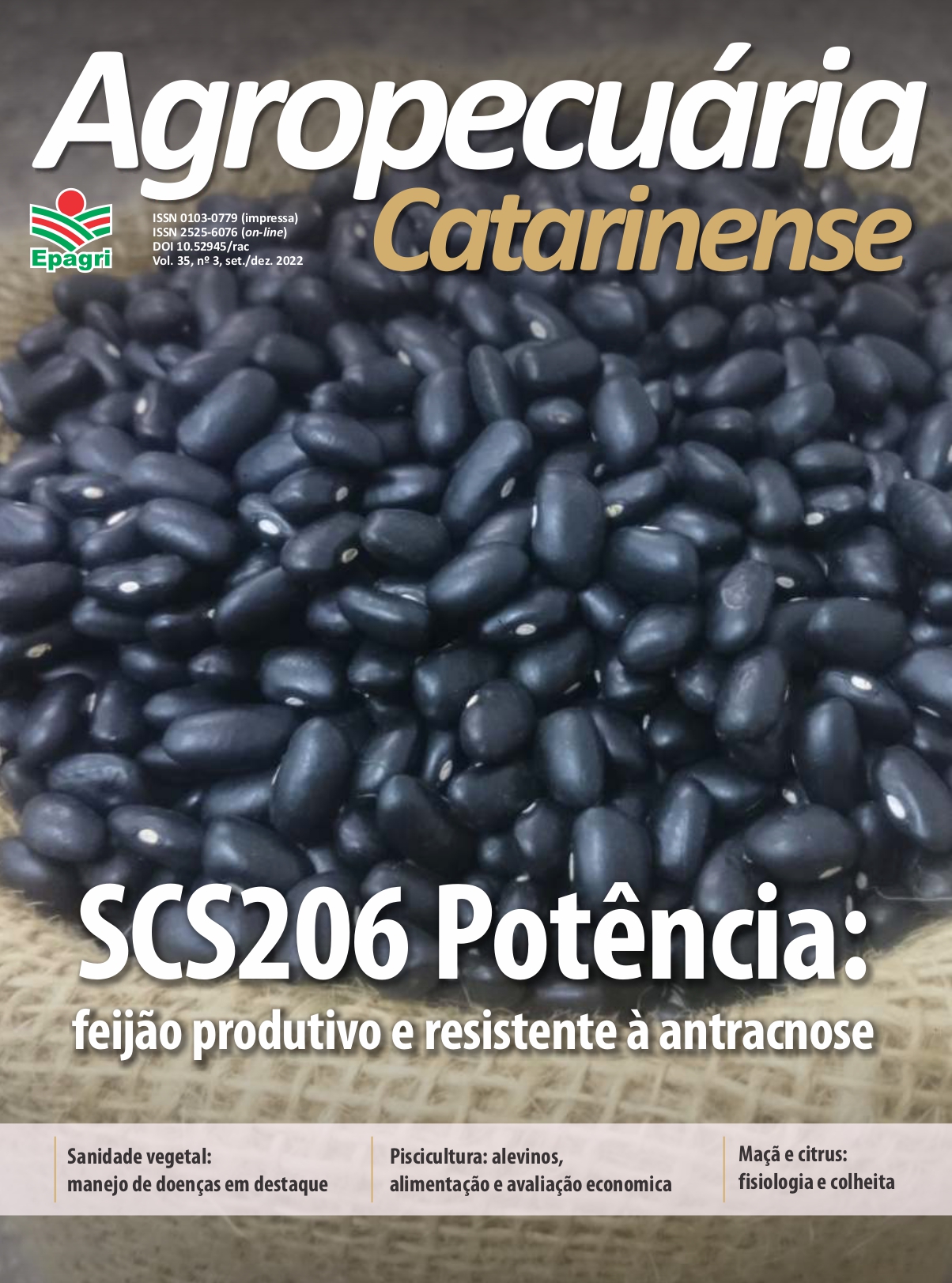re
DOI:
https://doi.org/10.52945/rac.v35i3.1496Keywords:
Oreochromis niloticus, reprodução, alevinagem, eficiência de produçãoAbstract
Tilapia farming is growing in recent years, and this is only possible with an increase in fingerling production, which is the basis of the production chain. The methodologies for reproductive management and production of tilapia fingerlings
are varied, with different levels of technology adoption, and, consequently, different production efficiencies. This study aimed to show an overview of the production of Nile tilapia fingerlings in Santa Catarina, through a questionnaire carried out with
fingerling producers. It was intended to detect bottlenecks or problems and possibilities for improvement in the production of fingerlings of this species in Santa Catarina. The production of tilapia fingerlings in Santa Catarina grew 62.7% between
the 2018/19 to 2020/21 seasons, concentrated in the Itajaí valley regions. However, there was a big variation in productive efficiency (fingerlings produced per area and per female) among fish farmers. Important points that can be improved include the use of more efficient methods to obtain larvae, use of technologies such as aerators associated with monitoring water quality, use of greenhouses in reproduction and hatchery, monitoring of sexual inversion rate, in addition to the periodic replacement of breeders in selection centers.
Metrics
Publication Facts
Reviewer profiles N/A
Author statements
- Academic society
- Epagri - Revista Agropecuária Catarinense
- Publisher
- Empresa de Pesquisa Agropecuária e Extensão Rural de Santa Catarina - Epagri
References
ALMEIDA, D.B., DA COSTA, M.A.P., BASSINI, L. N., CALABUIG, C.I.P., MOREIRA, C.G.A., RODRIGUES, M.D.N., PÉREZ, H.J.; TAVARES, R.A.; VARELA JR, A.S.; MOREIRA, H.L.M. (2013). Reproductive performance in female strains of Nile tilapia, Oreochromis niloticus. Aquaculture International, v.21, n.6, p.1291-1300, 2013. DOI:10.1007/s10499-013-9630-0.
BARROSO M.R.; TENÓRIO, R.A.; PEDROZA FILHO, M.X.; WEBBER, D.C.; BELCHIOR, L.S. Gerenciamento genético da tilápia nos cultivos comerciais. Palmas, TO, 2015. 64p. (Embrapa Pesca e Aquicultura. Documentos, 23).
CEDAP (Centro de Pesquisa em Aquicultura e Pesca). Tilápia GIFT-Epagri SC03. Florianópolis, SC, 2020. 2 p. (Epagri. Folder técnico).
CEPA/EPAGRI. Mapa interativo da produção de peixes. Disponível em: https://www.infoagro.sc.gov.br/index.php/safra/producao-animal-2. Acesso em: 11 maio 2022.
FEIDEN, A., RAMOS, M.J., CHIDICHIMA, A.C., SCHMIDT, C.M., FIORESE, M.L.; COLDEBELLA, A. A cadeia produtiva da tilápia no oeste do Paraná: uma análise sobre a formação de um arranjo produtivo local. Redes (St. Cruz do Sul Online), v.23, n.2, p.238-263, 2018. https://doi.org/10.17058/redes.v23i2.8992.
KUBITZA F. Tilápia: Tecnologia e planejamento na produção comercial. Jundiaí: Kubitza, 2011. 316p.
MARCHIORI, N.C., NOVAES, A.L.T.; DA SILVA, B.C. Desenvolvimento de um sistema piloto de informações geográficas para a gestão da piscicultura continental catarinense. Revista Agropecuária Catarinense, v.34, n.2, p.18-21, 2021. http//:dx.doi.org/10.52945/rac.v34i2.1040.
PEIXE-BR. Anuário Brasileiro da Piscicultura Peixes BR 2022. São Paulo: Associação Brasileira da Piscicultura, 2022. 79p.
PINHEIRO, M.F.M.; ZIMMERMANN, S.; AIUB, J.A.S.; FIESCKI, L.A. Observações sobre a temperatura do ar e da água de estufa tipo túnel plástico para o cultivo de tilápias, Oreochromis niloticus. Boletim do Instituto de Pesca, v.24, n. Especial, p.157-160, 1997.
RIBEIRO, R.P.; LEGAT, A.P. Delineamento de programas de melhoramento genético de espécies aqüícolas no Brasil. Teresina: Embrapa Meio-Norte, 2008. 25p. (Embrapa. Documentos 184).
SENAR. Piscicultura: reprodução, larvicultura e alevinagem de tilápias. Coleção SENAR, Brasília: SENAR, 2017, 85p.
SILVA, B.C.; MASSAGO, H.; MARCHIORI, N.C. Monocultivo de tilápia em viveiros escavados em Santa Catarina. Florianópolis, SC, 2019. 126p. (Epagri. Sistemas de Produção, 52).
SILVA, A.C.F.; CORRÊA FILHO, R.A.C.; VENTURA, A.S.; NUNES, A.L.; LAICE, L.M.; RIBEIRO, R.P.; OLIVEIRA, C.A.L.; ALMEIDA, L.C.; BARBOSA, P.T.L.; POVH, J.A. Reproductive traits in different Nile tilapia genetic groups. Arquivo Brasileiro de Medicina Veterinária e Zootecnia, v.72, n.5, p.1797-1804, 2020. https://doi.org/10.1590/1678-4162-11764.
Downloads
Published
How to Cite
Issue
Section
License
Copyright (c) 2022 Bruno Corrêa Silva, Raphael de Leão Serafini, Haluko Massago

This work is licensed under a Creative Commons Attribution 4.0 International License.





